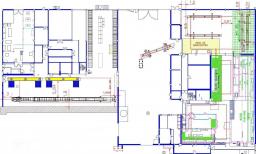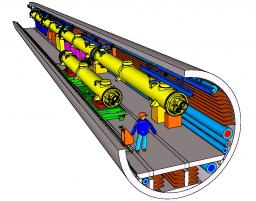The European X-ray Free Electron Laser (E-XFEL) project will use a 17.5 GeV electron beam to create an X-ray source that will be a million times more intense than synchrotron-based sources. Located in Hamburg, near DESY, the German Electron Synchrotron, it will be used to explore new areas of chemistry, biology, and material science, calling for intense and ultra-short (sub-picosecond) beams.
The instrument is built around a 17.5 GeV electron linac, 1.2 km in length. The linac includes superconducting RF cavities made of bulk niobium, developing a 23.6 MV/m accelerating field, similar to those used on FLASH, the 1 GeV accelerator at the DESY site. When completed in 2014, the E-XFEL will be the largest superconducting linear accelerator ever built. IRFU is working with teams from DESY, IN2P3-LAL, and the INFN on this project. It is responsible for integrating all 83 accelerating cryomodules at Saclay. For this purpose, SACM is developing an assembly infrastructure, called the “XFEL Village”, which will be made available to an industrial operator for the three years required for the operation.

Layout diagram of cryomodule assembly halls, including the large clean room where the cavity strings are integrated.
The layout of this infrastructure was proposed in 2008 as part of the preliminary industrialization study by Thales DIS. It consists of three assembly halls located around the courtyard of Installation 218. A line of seven workstations, designed to produce one cryomodule per week, will gradually integrate the different components of the cryomodule over seven weeks. Work will begin in the large clean room, with the assembly of eight superconducting accelerating cavities in a 12 meters long string. Other workstations are designed for aligning the cavities, placing them in the cryostat, and mounting the eight RF power couplers.
• Accelerator physics and technology › Electron-positron linear accelerators
• Accelerators, Cryogenics and Magnetism Division (DACM)
• LEDA



